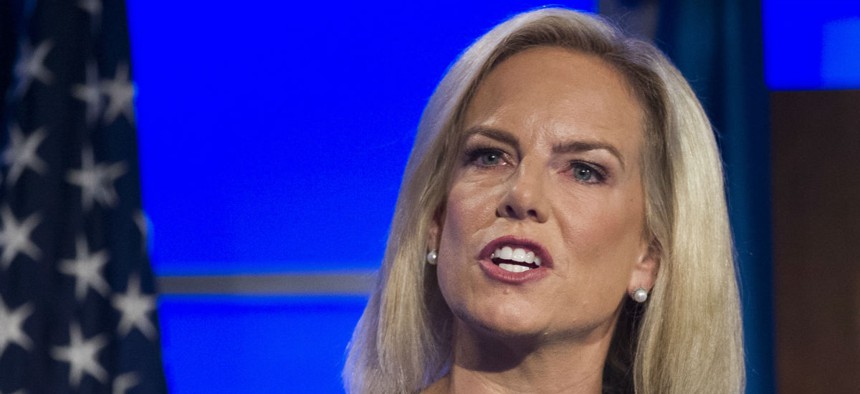Homeland Security Chief Previews Toughened 'Resiliency Agenda'
Trump administration declares end to “days of cyber surrender.”
The Trump administration is “replacing complacency with consequences” for nations that harbor terrorists posing online threats, Homeland Security Secretary Kirstjen Nielsen said on Wednesday.
“Our adversaries have been warned: the days of cyber surrender are over,” she told an audience at The George Washington University’s Center for Cyber Homeland Security.
Nielsen laid out five shifts reflected in a coming new department strategic plan for confronting rising threats in today’s “hyper-connected” digitized world.
“Power vacuums are springing up across the globe and are quickly filled by hostile nation-states, terrorists and transnational criminals,” she said at the event timed for the anniversary of the 9/11 terrorist attacks. “The pace of innovation, our hyperconnectivity, and our digital dependence have opened cracks in our defenses, creating new opportunities and new vectors through which these nefarious actors can strike us.”
Hence the plan from the White House and the department for “reasserting U.S. leadership,” she said. “We are building the toughest homeland security enterprise America has ever seen.”
The White House “very soon,” she announced, will release “a bold new counterterrorism strategy that will put our enemies on notice and lay out a path to victory against them.”
And the department in the coming months will launch a new multi-agency pilot “fusion cell” to create a global approach to crush “transnational criminal organizations” that exploit online communication to commit forgery, smuggling, drug running, human trafficking and murder.
Nielsen’s five prongs were dealing with technological communication in a “borderless world,” the rise of transnational crime, the re-rise of hostile nation states that put the “threat to the United States at the highest level of the Cold War,” cyber-attacks that have eclipsed the threat of physical attacks and accelerated high-tech innovation as represented by drones.
“Home games and away games are no longer distinct,” Nielsen said of the threat from criminals and terrorists who “don’t respect our borders.” Those threats “have spread across the globe at fiber-optic speeds.” Because “dangerous actors are crowd-sourcing chaos,” she said, the United States and partners must “crowd-source our response.”
Addressing President Trump’s travel ban, Nielsen said it was directed in part against countries that declined to cooperate in international data sharing on terrorist threats, announcing that she will soon give Trump recommendations on how to step up sharing.
Nielsen lauded recent initiatives and reorganizations within DHS. “We have implemented the toughest screening and vetting measures ever to help us weed out violent extremists,” she said. She cited last December’s formation of the DHS Office of Countering Weapons of Mass Destruction as “the largest DHS reorganization in years.”
Congress, however, should pass legislation to give that office more authority to track chemical and biological threats, she said. Congress should also provide a formal reauthorization of DHS’s cybersecurity arm—the National Protection and Programs Directorate—and more departmental authority to guard against the threat of weapons carried by drones, she added.
One area that continues to be a top priority is sharing intelligence with election officials wary of meddling on the scale executed by Russia in 2016, she said, calling that “a direct attack on our democracy.” By the midterm elections this year, “more than 90 percent of registered voters will live in an area where our network security sensors are deployed on their election infrastructure,” she said. “This is unprecedented.”
Nielsen called upon every state before the 2020 election to implement “redundant, auditable election systems,” with paper trails that allow future auditing.
Addressing the cybersecurity challenge, Nielsen mentioned July’s “first-ever National Cybersecurity Summit” and her announcement of the launch of the DHS National Risk Management Center as a central hub for government and private sector partners to share information.
Nielsen said she was “looking forward to being welcomed at the new DHS headquarters at St. Elizabeths,” perhaps next year. “The new building will do justice” to the modern DHS, she added, recalling her early days with the new department in a GSA building filled with cockroaches, asbestos and little employee privacy.
Following her rundown of rising threats, Nielsen said the 240,000 DHS employees have “found an antidote to this acrimony, and it’s called mission.” Sometimes, she feels “there are more critics than doers,” she said. “After nine months on the job, she added, “what gets me up in the morning is supporting the men and women of the Department of Heroes.”




